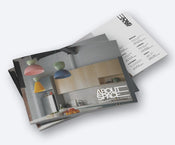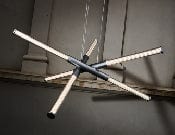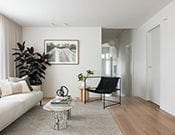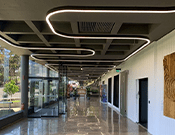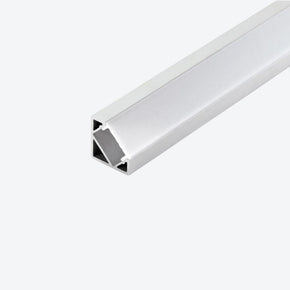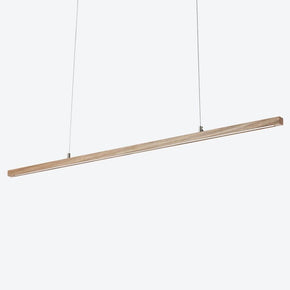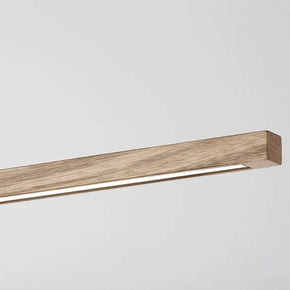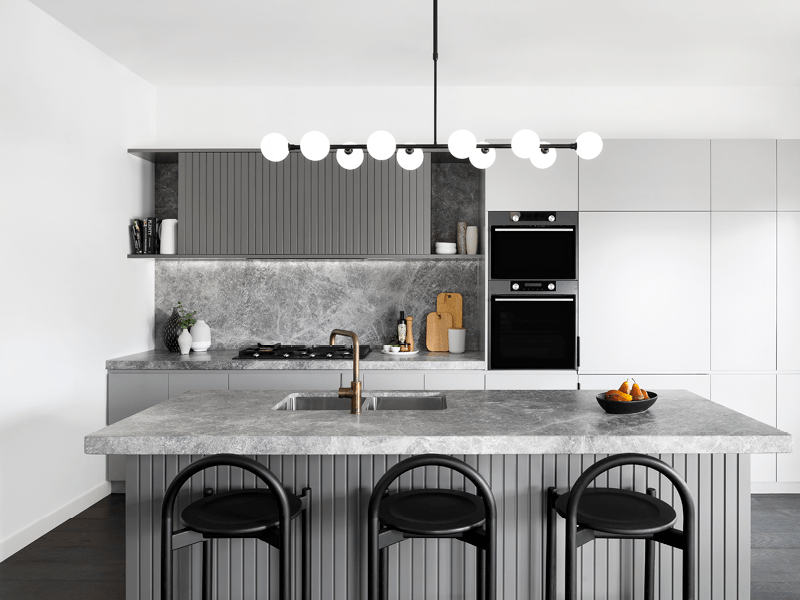- No products in the cart.
- ``
Everything you need to know about LED strip lighting
14
Apr
Strip and profile lights are some of the most versatile styles on the market. The perfect complement to your home’s lighting plan, strip lighting enables you to illuminate any nook and cranny in your home, no matter the size or shape!
What is LED strip lighting?
LED strip lights are a versatile form of lighting that consist of small LEDs mounted on a narrow strip of flexible circuit board. Often, strip lighting is available for purchase as is (with no cover), but for a higher end look, strip lighting comes encased in a profile - an aluminium case that’s moulded to fit any space with a diffuser to reduce the spotted look.
About the strip
An LED strip is just over 1cm in width with a customisable length. Individual LEDs are mounted onto the strip, with 60 to 120 LEDs per metre. The strip includes an adhesive backing, so it can be installed on any surface.
LED strip brightness
LED strip brightness is measured in lumens and generally measured in lumens per metre. A good quality 15W LED strip should measure 1500 lumens per metre at a minimum. The brightness of an LED strip is determined by the efficiency of each individual LED emitter and the number of LEDs per metre and the power draw of the LEDs per metre.
LED density
LED density refers to the number of LEDs per metre of strip and the space between individual emitters. This determines the spread and distribution of light. The higher the density, the more even the light. If you’re comparing the price of different strips, remember to consider LED density as this is often the factor that contributes to a difference in price (the LED emitters are the most expensive component to manufacture)
Power draw per foot
The power draw is measured in watts and determines how much power the system will use. This will impact how efficient the system is, as well as your electricity costs and how long the strip will last. For a bright high quality LED strip, choose one with an output of at least 15W per metre. Cheaper products may overdrive the LED emitters by driving too many watts into the system. This can cause the system to fail. To check, divide the wattage per metre by the LED density per foot.
Colour and colour temperature
LED strips are available in standard cool or warm whites but also come in a range of colours. A fixed single colour LED strip emits a single coloured light. Colour changing LED strips consist of a single strip with different coloured LEDs. Also called RGB strips, these strips contain the basic building blocks of all colours, allowing you to mix different colours together to achieve basically any colour. Then there are the strip lights that allow you to control the colour temperature, enabling you to adjust the warmness and coolness of the light!
Voltage and power supply
Most lighting strips will come in either 12v or 24v. 12v lights will generally give you more options when choosing other components. But if your strip is more than 10 metres in length, choose a 24v strip.
Drivers and transformers
All LED strips operate on DC (direct current), while the power that comes out of the wall socket is AC (alternating current). LEDs need only a small regulated amount of DC to operate best. Because of this, LED strips lights need a driver or a transformer. Drivers and transformers convert AC to DC, while also reducing the amount of power that flows to the system. Without the driver, the system would receive too much power, which would cause it to fail.
Depending on the manufacturer of the LED system, you’ll need either a transformer or a driver. Using a transformer on a product that was designed to work with a driver (and vice versa) will result in damage to the system, so it’s important to check. You can’t use an AC transformer on a DC product and vice-versa. Always check.
When choosing a driver, you should pick one which is 20% higher wattage than the light source, to allow for any fluctuations in power. To determine which driver to use, work out the total wattage of the strip by multiplying the wattage per metre by the length of the strip plus 20%.
Wattage
Most LED strips are installed to create a soft warm glow. Because of this, you want to choose an LED strip with a low wattage - lower than 5 watts for this ambient light. For areas that need a stronger light, such as in cupboards - go for a wattage of about 10 watt per metre. For offices that need an even stronger light, 15 watts per metre is a good bet. If you are worried about it being too bright, select a dimmable driver
Profiles and heat sinks
As mentioned, for a higher end look, strip lighting will come in aluminum profiles with diffusers that can be made to fit any spot. The aluminium cover not only hides the bare circuit board, but also the diffuser diffuses the light for a more aesthetically pleasing lighting effect. The added benefit of the profile is that it acts as a heat sink. While cool to the touch, LEDs actually produce a lot of unwanted heat. You can not feel the heat, but it exists inside the LEDs and can do damage to the system if not dealt with effectively. This is where a heat sink comes in handy. Heat sinks dissipate the unwanted heat. Profiles enable you not only to mount the light, but also act as a heat sink. That being said, higher quality LED strips generally underdrive the LEDs so there is little risk of the system producing too much heat to handle.
Controllers
LEDs come with a controller that enables you to adjust the LED. This gives you the freedom to adjust an array of elements, such as the colour, the brightness (dimming), colour temperature, zone, timers, speed, etc.
LEDs can be controlled through a controller installed and mounted to the wall, a remote or the wifi on your phone.
Colour temperature
When picking colour temperature (kelvin), try to match the colour temperature of any surrounding lighting to help it blend in. For a warm ambient atmosphere, opt for a colour temperature of 2700k to 3000k. Or, if you’re after something a little cooler, go for about 4000k. This will give you a natural look. If you’re installing strip lighting in an office space, then a 5000k will give you a nice clean and clear light, similar to daylight.
How to connect LED strips
Once the driver or transformer is connected to the wall and to the strip, you can connect other strips to the first. This is called a daisy chain. Strips can be joined together, although this should only be done by an experienced electrician. For all small and more complex projects, a high quality outcome or if you want it wired to a wall switch, you’ll need to engage an electrician to install it.
Where to use it
The great thing about strip lighting is its versatility. The strip and profile can be cut to size and shaped for installation almost anywhere. It can be mounted on curved walls and tucked away out of site to give off soft and warm illumination.
Common spots for installing strip lighting in the home include inside cabinets, under cabinets and splashbacks, on shelves inside cabinets and pantries, on open shelves, on the recess between a kitchen island and floor, underneath vanities or around bathroom mirrors, the bottom of bathtubs, under beds and bedheads, under furniture, behind picture frames and on staircases. You can have it installed on the ceiling instead of downlights, to light up a room. The options are practically endless. Strip lighting provides a soft and luxurious warm glow that looks great almost anywhere. If you’re thinking of installing strip lighting in the bathroom, just be careful to choose one with the correct IP rating (read more about IP ratings here).
Ready to install strip lighting in your home or commercial space?
We stock a range of strip and profile lighting that can be cut to any size. View our range of strip and profile lighting or get in touch with an About Space lighting specialist to learn more about this versatile lighting option.

